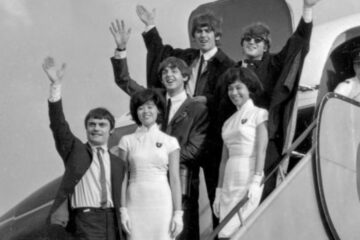Most of the British invasion bands that began to crop up in the early 1960s set out using the sturdy crutch of rhythm and blues covers. Famously, The Rolling Stones remained dutiful to their roots, with covers making up the majority of their first couple of albums. As a long-lived skiffle act previously known as The Quarrymen, The Beatles discarded their inflatable armbands a little earlier.
John Lennon and Paul McCartney first met at a Church Hall fete in Woolton, Liverpool, in 1957. At the time, Lennon had already founded his first band, and after discovering McCartney’s mutual appreciation for early American rock ‘n’ roll music, he invited him to join as a rhythm guitarist. As George Harrison realised a year or so later, Lennon was fond of auditioning his prospective bandmates, no matter how passionate they were.
In his book The Lyrics: 1956 to the Present, McCartney fondly recalled his audition. “One thing led to another – typical teenage boys posturing and the like – and ended up showing off a little by playing Eddie Cochran’s ‘Twenty Flight Rock’ on the guitar,” he wrote. “I think l also played Gene Vincent’s ‘Be-Bop-a-Lula’ and a few Little Richard songs too.”
McCartney pushed all the right buttons and swiftly became Lennon’s right-hand man. Approaching adulthood, the pair began to meet for special one-to-one jam sessions in the former’s bedroom at his aunt’s house. They used to play along to classic records by popular artists, including Buddy Holly, Little Richard, Fats Domino and Eddie Cochran. In due course, they began to write songs of their own.
As two halves of the most successful songwriting partnership of all time, Lennon and McCartney have cited an almost telepathic connection that allowed them to communicate when composing songs together. Some of The Beatles’ greatest songs, including ‘A Day in the Life’, were highly collaborative, with different verses attributed to each writer. However, for the most part, the pair would come up with lyrical and instrumental ideas individually before presenting them to the other for advice and completion.

At some point, especially towards the end of The Beatles’ time together, Lennon and McCartney’s partnership seemed to falter under a clash of opinions. Famously, Lennon, Harrison and Ringo Starr despised McCartney’s “fruity” work on ‘Maxwell’s Silver Hammer’ in 1969. Two years prior, Lennon expressed similar feelings about ‘Hello, Goodbye’, the band’s first single following the death of Brian Epstein in 1967.
Principally, Lennon disliked the song because of McCartney’s nonsensical lyrics. He once described it as “three minutes of contradictions and meaningless juxtapositions”. The song is widely adored for its pleasant instrumentation, but one can understand Lennon’s criticisms, especially when considering the fact that McCartney pushed ‘Hello, Goodbye’ onto the single’s A-side, leaving side B for Lennon’s ‘I Am The Walrus’.
McCartney wrote ‘Hello, Goodbye’ as an intentionally simplistic song following the success of the previous single, ‘All You Need Is Love’. Such songs stood a much greater chance of achieving success on an international scale. According to Alistair Taylor, former assistant to Epstein, McCartney first got the idea for the song on a visit to his house in St. John’s Wood.
Taylor, who later became the general manager of Apple Corps, asked McCartney how he writes his songs. “Paul marched me into the dining room, where he had a marvellous old hand-carved harmonium,” he remembered. “‘Come and sit at the other end of the harmonium. You hit any note you like on the keyboard. Just hit it, and I’ll do the same. Now, whenever I shout out a word, you shout the opposite, and I’ll make up a tune. You watch, it’ll make music.’”
This conversational duality inspired McCartney to construct the eventual single. “It’s such a deep theme in the universe, duality – man/woman, black/white, ebony/ivory, high/low, right/wrong, up/down, hello/goodbye – that it was a very easy song to write,” McCartney reflected on the song in Many Years From Now. “It’s just a song of duality, with me advocating the more positive. You say goodbye, I say hello. You say stop, I say go. I was advocating the more positive side of the duality, and I still do to this day.”




